Foundation of Law: Case Study on Interpretation of Section 81 of Summary Offences Act 1953 (SA)
VerifiedAdded on 2023/06/09
|13
|3532
|392
AI Summary
This case study discusses the interpretation of section 81 of the Summary Offences Act 1953 (SA) in relation to the medical examination of the accused in custody. It also discusses the significance of judicial precedents and relevant case laws.
Contribute Materials
Your contribution can guide someone’s learning journey. Share your
documents today.
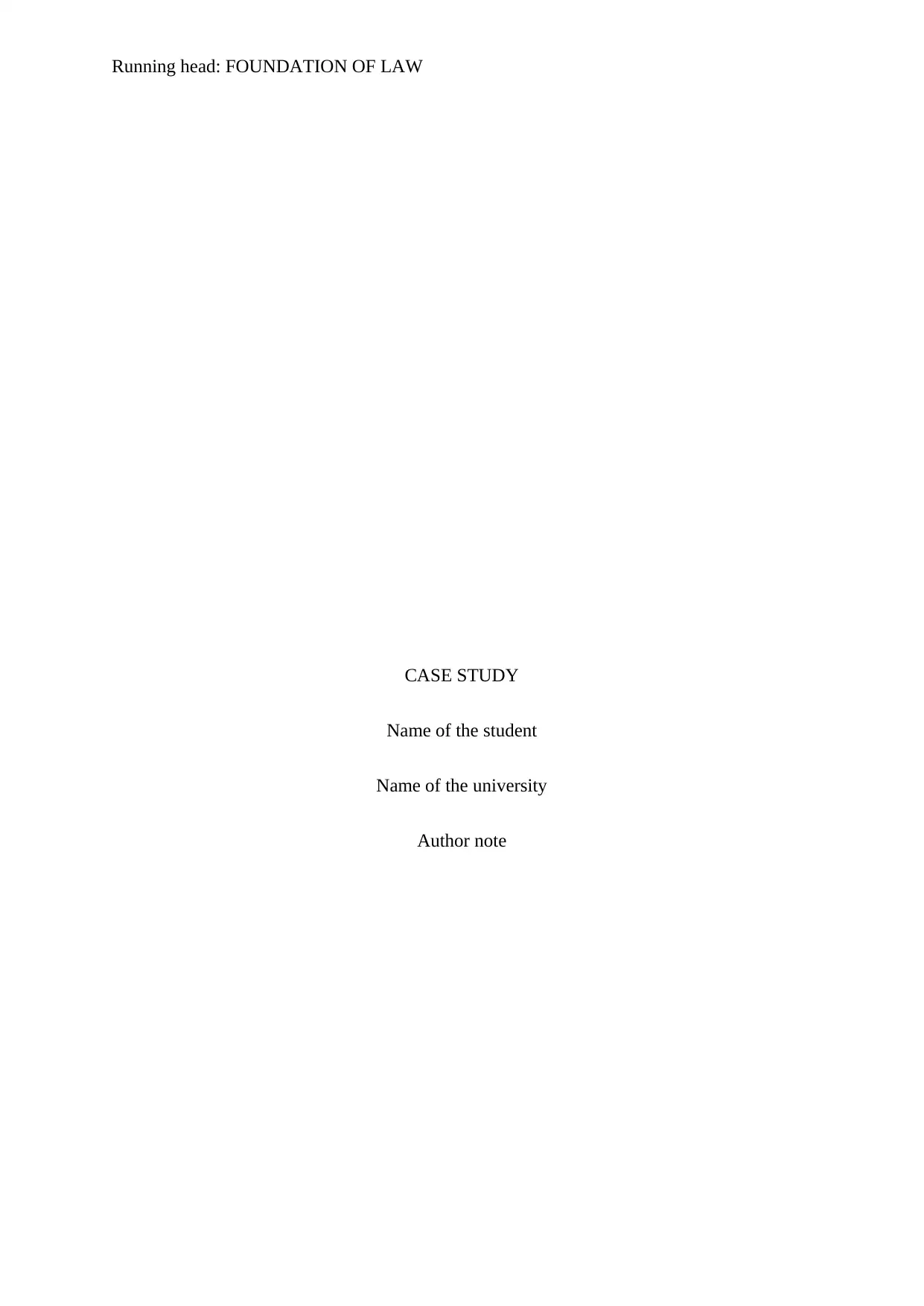
Running head: FOUNDATION OF LAW
CASE STUDY
Name of the student
Name of the university
Author note
CASE STUDY
Name of the student
Name of the university
Author note
Secure Best Marks with AI Grader
Need help grading? Try our AI Grader for instant feedback on your assignments.
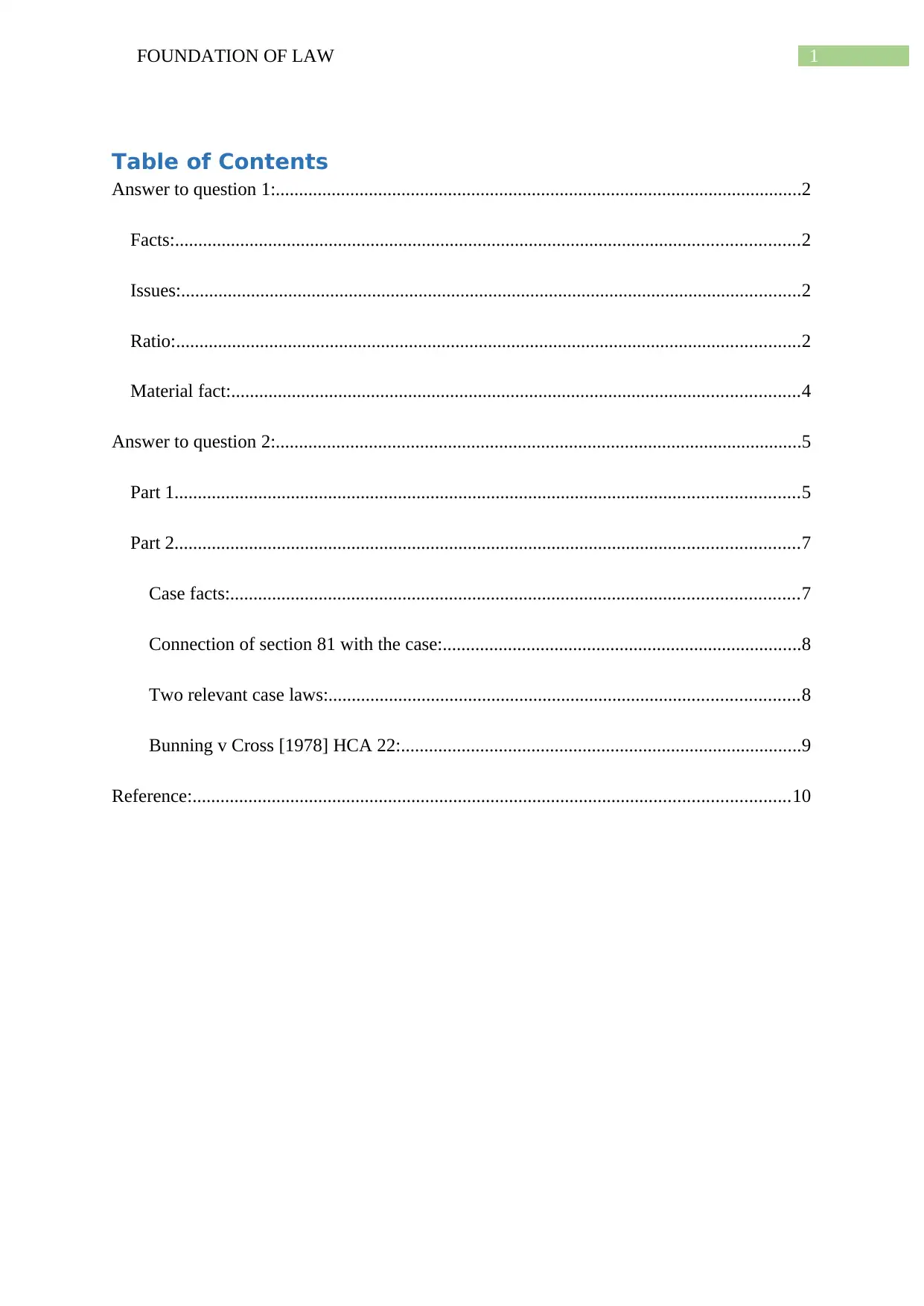
1FOUNDATION OF LAW
Table of Contents
Answer to question 1:.................................................................................................................2
Facts:......................................................................................................................................2
Issues:.....................................................................................................................................2
Ratio:......................................................................................................................................2
Material fact:..........................................................................................................................4
Answer to question 2:.................................................................................................................5
Part 1......................................................................................................................................5
Part 2......................................................................................................................................7
Case facts:..........................................................................................................................7
Connection of section 81 with the case:.............................................................................8
Two relevant case laws:.....................................................................................................8
Bunning v Cross [1978] HCA 22:......................................................................................9
Reference:................................................................................................................................10
Table of Contents
Answer to question 1:.................................................................................................................2
Facts:......................................................................................................................................2
Issues:.....................................................................................................................................2
Ratio:......................................................................................................................................2
Material fact:..........................................................................................................................4
Answer to question 2:.................................................................................................................5
Part 1......................................................................................................................................5
Part 2......................................................................................................................................7
Case facts:..........................................................................................................................7
Connection of section 81 with the case:.............................................................................8
Two relevant case laws:.....................................................................................................8
Bunning v Cross [1978] HCA 22:......................................................................................9
Reference:................................................................................................................................10
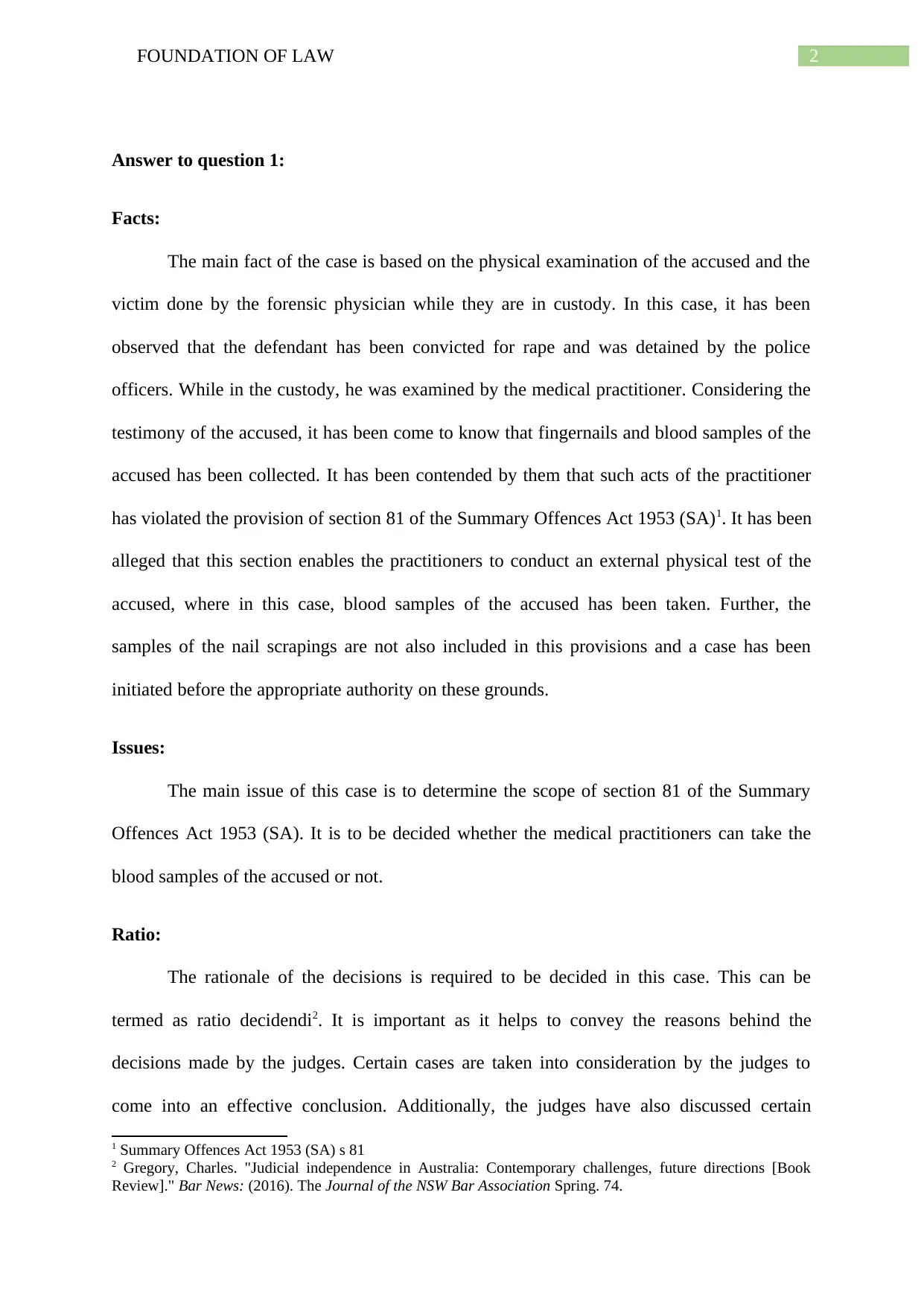
2FOUNDATION OF LAW
Answer to question 1:
Facts:
The main fact of the case is based on the physical examination of the accused and the
victim done by the forensic physician while they are in custody. In this case, it has been
observed that the defendant has been convicted for rape and was detained by the police
officers. While in the custody, he was examined by the medical practitioner. Considering the
testimony of the accused, it has been come to know that fingernails and blood samples of the
accused has been collected. It has been contended by them that such acts of the practitioner
has violated the provision of section 81 of the Summary Offences Act 1953 (SA)1. It has been
alleged that this section enables the practitioners to conduct an external physical test of the
accused, where in this case, blood samples of the accused has been taken. Further, the
samples of the nail scrapings are not also included in this provisions and a case has been
initiated before the appropriate authority on these grounds.
Issues:
The main issue of this case is to determine the scope of section 81 of the Summary
Offences Act 1953 (SA). It is to be decided whether the medical practitioners can take the
blood samples of the accused or not.
Ratio:
The rationale of the decisions is required to be decided in this case. This can be
termed as ratio decidendi2. It is important as it helps to convey the reasons behind the
decisions made by the judges. Certain cases are taken into consideration by the judges to
come into an effective conclusion. Additionally, the judges have also discussed certain
1 Summary Offences Act 1953 (SA) s 81
2 Gregory, Charles. "Judicial independence in Australia: Contemporary challenges, future directions [Book
Review]." Bar News: (2016). The Journal of the NSW Bar Association Spring. 74.
Answer to question 1:
Facts:
The main fact of the case is based on the physical examination of the accused and the
victim done by the forensic physician while they are in custody. In this case, it has been
observed that the defendant has been convicted for rape and was detained by the police
officers. While in the custody, he was examined by the medical practitioner. Considering the
testimony of the accused, it has been come to know that fingernails and blood samples of the
accused has been collected. It has been contended by them that such acts of the practitioner
has violated the provision of section 81 of the Summary Offences Act 1953 (SA)1. It has been
alleged that this section enables the practitioners to conduct an external physical test of the
accused, where in this case, blood samples of the accused has been taken. Further, the
samples of the nail scrapings are not also included in this provisions and a case has been
initiated before the appropriate authority on these grounds.
Issues:
The main issue of this case is to determine the scope of section 81 of the Summary
Offences Act 1953 (SA). It is to be decided whether the medical practitioners can take the
blood samples of the accused or not.
Ratio:
The rationale of the decisions is required to be decided in this case. This can be
termed as ratio decidendi2. It is important as it helps to convey the reasons behind the
decisions made by the judges. Certain cases are taken into consideration by the judges to
come into an effective conclusion. Additionally, the judges have also discussed certain
1 Summary Offences Act 1953 (SA) s 81
2 Gregory, Charles. "Judicial independence in Australia: Contemporary challenges, future directions [Book
Review]." Bar News: (2016). The Journal of the NSW Bar Association Spring. 74.
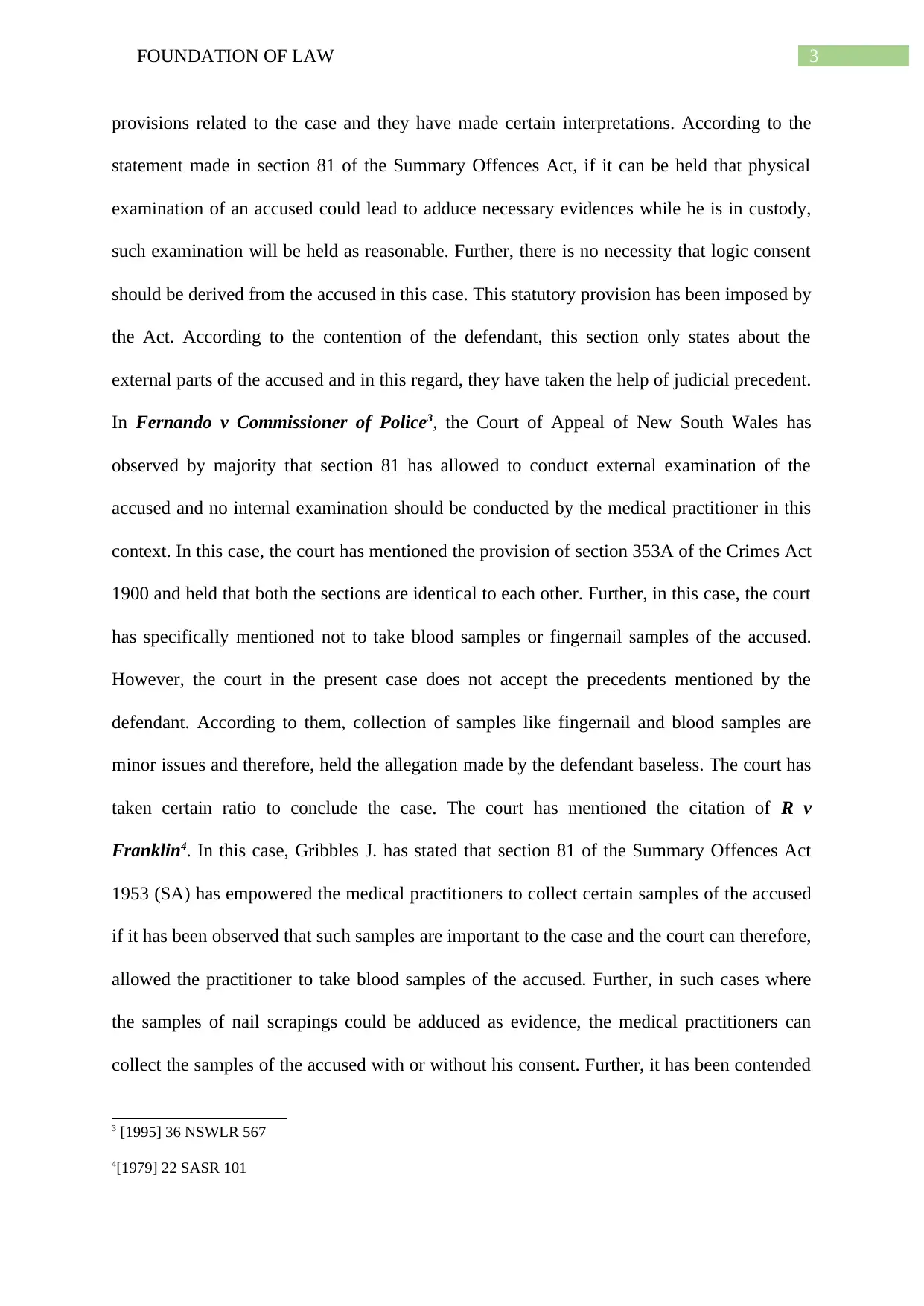
3FOUNDATION OF LAW
provisions related to the case and they have made certain interpretations. According to the
statement made in section 81 of the Summary Offences Act, if it can be held that physical
examination of an accused could lead to adduce necessary evidences while he is in custody,
such examination will be held as reasonable. Further, there is no necessity that logic consent
should be derived from the accused in this case. This statutory provision has been imposed by
the Act. According to the contention of the defendant, this section only states about the
external parts of the accused and in this regard, they have taken the help of judicial precedent.
In Fernando v Commissioner of Police3, the Court of Appeal of New South Wales has
observed by majority that section 81 has allowed to conduct external examination of the
accused and no internal examination should be conducted by the medical practitioner in this
context. In this case, the court has mentioned the provision of section 353A of the Crimes Act
1900 and held that both the sections are identical to each other. Further, in this case, the court
has specifically mentioned not to take blood samples or fingernail samples of the accused.
However, the court in the present case does not accept the precedents mentioned by the
defendant. According to them, collection of samples like fingernail and blood samples are
minor issues and therefore, held the allegation made by the defendant baseless. The court has
taken certain ratio to conclude the case. The court has mentioned the citation of R v
Franklin4. In this case, Gribbles J. has stated that section 81 of the Summary Offences Act
1953 (SA) has empowered the medical practitioners to collect certain samples of the accused
if it has been observed that such samples are important to the case and the court can therefore,
allowed the practitioner to take blood samples of the accused. Further, in such cases where
the samples of nail scrapings could be adduced as evidence, the medical practitioners can
collect the samples of the accused with or without his consent. Further, it has been contended
3 [1995] 36 NSWLR 567
4[1979] 22 SASR 101
provisions related to the case and they have made certain interpretations. According to the
statement made in section 81 of the Summary Offences Act, if it can be held that physical
examination of an accused could lead to adduce necessary evidences while he is in custody,
such examination will be held as reasonable. Further, there is no necessity that logic consent
should be derived from the accused in this case. This statutory provision has been imposed by
the Act. According to the contention of the defendant, this section only states about the
external parts of the accused and in this regard, they have taken the help of judicial precedent.
In Fernando v Commissioner of Police3, the Court of Appeal of New South Wales has
observed by majority that section 81 has allowed to conduct external examination of the
accused and no internal examination should be conducted by the medical practitioner in this
context. In this case, the court has mentioned the provision of section 353A of the Crimes Act
1900 and held that both the sections are identical to each other. Further, in this case, the court
has specifically mentioned not to take blood samples or fingernail samples of the accused.
However, the court in the present case does not accept the precedents mentioned by the
defendant. According to them, collection of samples like fingernail and blood samples are
minor issues and therefore, held the allegation made by the defendant baseless. The court has
taken certain ratio to conclude the case. The court has mentioned the citation of R v
Franklin4. In this case, Gribbles J. has stated that section 81 of the Summary Offences Act
1953 (SA) has empowered the medical practitioners to collect certain samples of the accused
if it has been observed that such samples are important to the case and the court can therefore,
allowed the practitioner to take blood samples of the accused. Further, in such cases where
the samples of nail scrapings could be adduced as evidence, the medical practitioners can
collect the samples of the accused with or without his consent. Further, it has been contended
3 [1995] 36 NSWLR 567
4[1979] 22 SASR 101
Secure Best Marks with AI Grader
Need help grading? Try our AI Grader for instant feedback on your assignments.
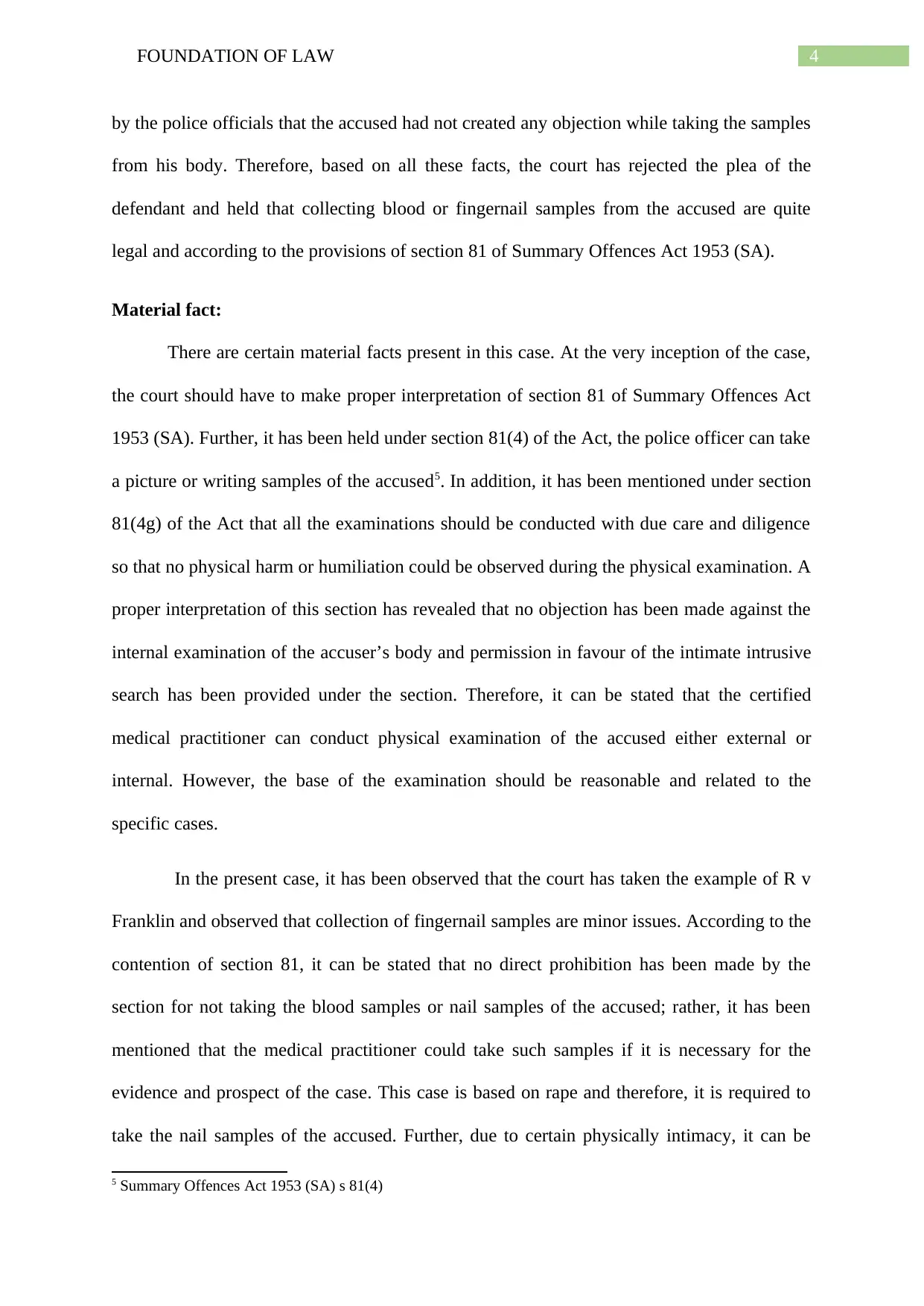
4FOUNDATION OF LAW
by the police officials that the accused had not created any objection while taking the samples
from his body. Therefore, based on all these facts, the court has rejected the plea of the
defendant and held that collecting blood or fingernail samples from the accused are quite
legal and according to the provisions of section 81 of Summary Offences Act 1953 (SA).
Material fact:
There are certain material facts present in this case. At the very inception of the case,
the court should have to make proper interpretation of section 81 of Summary Offences Act
1953 (SA). Further, it has been held under section 81(4) of the Act, the police officer can take
a picture or writing samples of the accused5. In addition, it has been mentioned under section
81(4g) of the Act that all the examinations should be conducted with due care and diligence
so that no physical harm or humiliation could be observed during the physical examination. A
proper interpretation of this section has revealed that no objection has been made against the
internal examination of the accuser’s body and permission in favour of the intimate intrusive
search has been provided under the section. Therefore, it can be stated that the certified
medical practitioner can conduct physical examination of the accused either external or
internal. However, the base of the examination should be reasonable and related to the
specific cases.
In the present case, it has been observed that the court has taken the example of R v
Franklin and observed that collection of fingernail samples are minor issues. According to the
contention of section 81, it can be stated that no direct prohibition has been made by the
section for not taking the blood samples or nail samples of the accused; rather, it has been
mentioned that the medical practitioner could take such samples if it is necessary for the
evidence and prospect of the case. This case is based on rape and therefore, it is required to
take the nail samples of the accused. Further, due to certain physically intimacy, it can be
5 Summary Offences Act 1953 (SA) s 81(4)
by the police officials that the accused had not created any objection while taking the samples
from his body. Therefore, based on all these facts, the court has rejected the plea of the
defendant and held that collecting blood or fingernail samples from the accused are quite
legal and according to the provisions of section 81 of Summary Offences Act 1953 (SA).
Material fact:
There are certain material facts present in this case. At the very inception of the case,
the court should have to make proper interpretation of section 81 of Summary Offences Act
1953 (SA). Further, it has been held under section 81(4) of the Act, the police officer can take
a picture or writing samples of the accused5. In addition, it has been mentioned under section
81(4g) of the Act that all the examinations should be conducted with due care and diligence
so that no physical harm or humiliation could be observed during the physical examination. A
proper interpretation of this section has revealed that no objection has been made against the
internal examination of the accuser’s body and permission in favour of the intimate intrusive
search has been provided under the section. Therefore, it can be stated that the certified
medical practitioner can conduct physical examination of the accused either external or
internal. However, the base of the examination should be reasonable and related to the
specific cases.
In the present case, it has been observed that the court has taken the example of R v
Franklin and observed that collection of fingernail samples are minor issues. According to the
contention of section 81, it can be stated that no direct prohibition has been made by the
section for not taking the blood samples or nail samples of the accused; rather, it has been
mentioned that the medical practitioner could take such samples if it is necessary for the
evidence and prospect of the case. This case is based on rape and therefore, it is required to
take the nail samples of the accused. Further, due to certain physically intimacy, it can be
5 Summary Offences Act 1953 (SA) s 81(4)
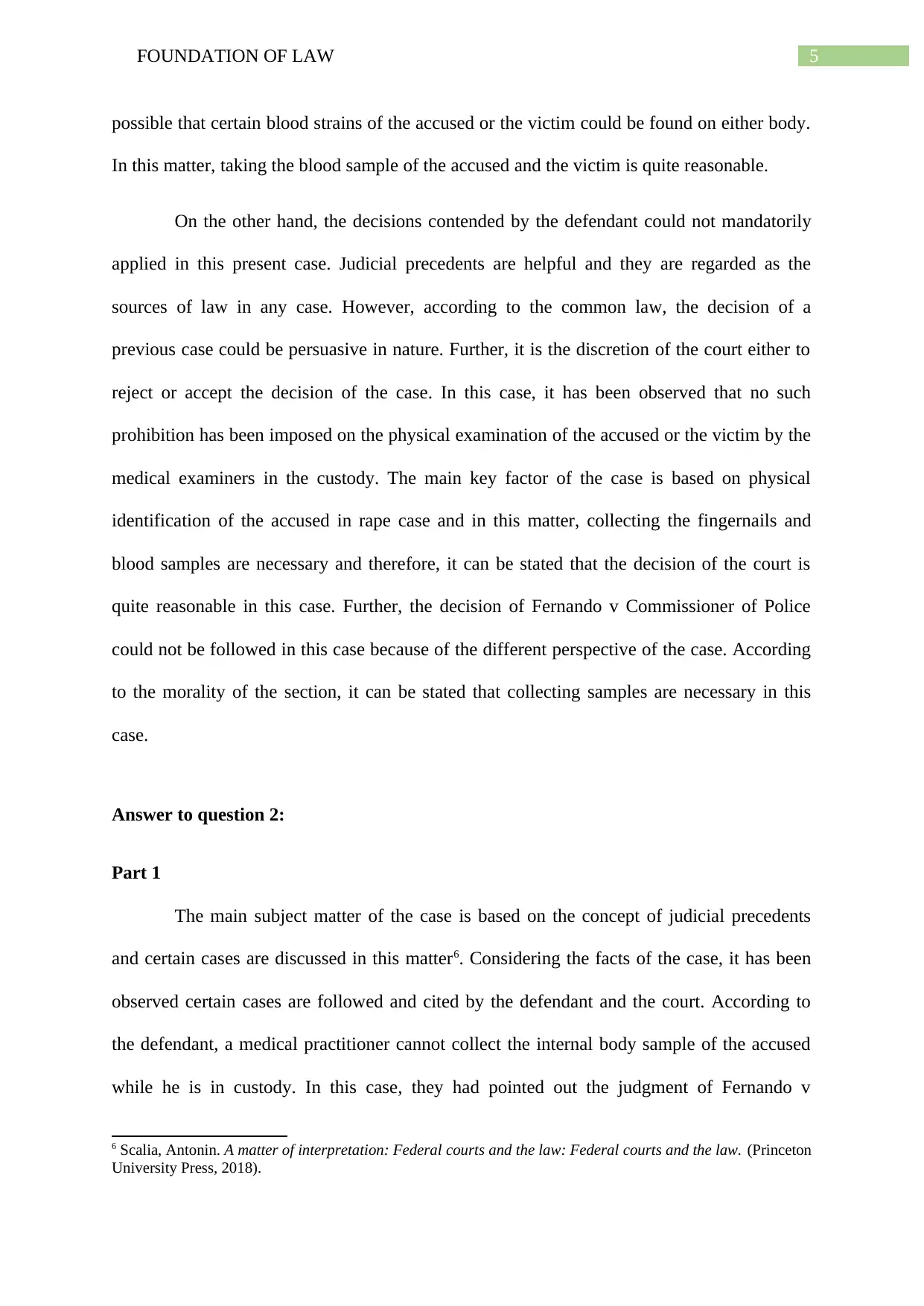
5FOUNDATION OF LAW
possible that certain blood strains of the accused or the victim could be found on either body.
In this matter, taking the blood sample of the accused and the victim is quite reasonable.
On the other hand, the decisions contended by the defendant could not mandatorily
applied in this present case. Judicial precedents are helpful and they are regarded as the
sources of law in any case. However, according to the common law, the decision of a
previous case could be persuasive in nature. Further, it is the discretion of the court either to
reject or accept the decision of the case. In this case, it has been observed that no such
prohibition has been imposed on the physical examination of the accused or the victim by the
medical examiners in the custody. The main key factor of the case is based on physical
identification of the accused in rape case and in this matter, collecting the fingernails and
blood samples are necessary and therefore, it can be stated that the decision of the court is
quite reasonable in this case. Further, the decision of Fernando v Commissioner of Police
could not be followed in this case because of the different perspective of the case. According
to the morality of the section, it can be stated that collecting samples are necessary in this
case.
Answer to question 2:
Part 1
The main subject matter of the case is based on the concept of judicial precedents
and certain cases are discussed in this matter6. Considering the facts of the case, it has been
observed certain cases are followed and cited by the defendant and the court. According to
the defendant, a medical practitioner cannot collect the internal body sample of the accused
while he is in custody. In this case, they had pointed out the judgment of Fernando v
6 Scalia, Antonin. A matter of interpretation: Federal courts and the law: Federal courts and the law. (Princeton
University Press, 2018).
possible that certain blood strains of the accused or the victim could be found on either body.
In this matter, taking the blood sample of the accused and the victim is quite reasonable.
On the other hand, the decisions contended by the defendant could not mandatorily
applied in this present case. Judicial precedents are helpful and they are regarded as the
sources of law in any case. However, according to the common law, the decision of a
previous case could be persuasive in nature. Further, it is the discretion of the court either to
reject or accept the decision of the case. In this case, it has been observed that no such
prohibition has been imposed on the physical examination of the accused or the victim by the
medical examiners in the custody. The main key factor of the case is based on physical
identification of the accused in rape case and in this matter, collecting the fingernails and
blood samples are necessary and therefore, it can be stated that the decision of the court is
quite reasonable in this case. Further, the decision of Fernando v Commissioner of Police
could not be followed in this case because of the different perspective of the case. According
to the morality of the section, it can be stated that collecting samples are necessary in this
case.
Answer to question 2:
Part 1
The main subject matter of the case is based on the concept of judicial precedents
and certain cases are discussed in this matter6. Considering the facts of the case, it has been
observed certain cases are followed and cited by the defendant and the court. According to
the defendant, a medical practitioner cannot collect the internal body sample of the accused
while he is in custody. In this case, they had pointed out the judgment of Fernando v
6 Scalia, Antonin. A matter of interpretation: Federal courts and the law: Federal courts and the law. (Princeton
University Press, 2018).
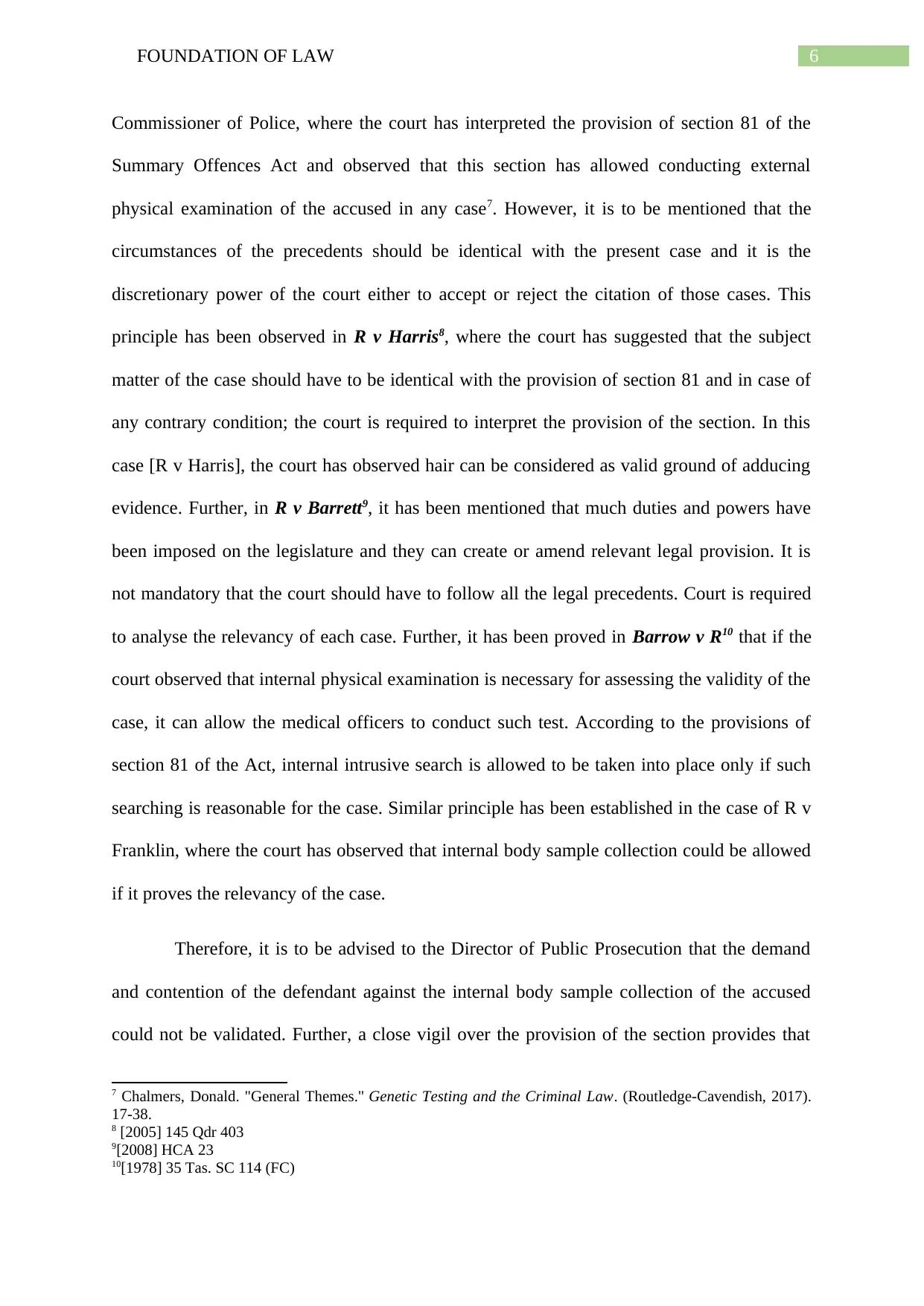
6FOUNDATION OF LAW
Commissioner of Police, where the court has interpreted the provision of section 81 of the
Summary Offences Act and observed that this section has allowed conducting external
physical examination of the accused in any case7. However, it is to be mentioned that the
circumstances of the precedents should be identical with the present case and it is the
discretionary power of the court either to accept or reject the citation of those cases. This
principle has been observed in R v Harris8, where the court has suggested that the subject
matter of the case should have to be identical with the provision of section 81 and in case of
any contrary condition; the court is required to interpret the provision of the section. In this
case [R v Harris], the court has observed hair can be considered as valid ground of adducing
evidence. Further, in R v Barrett9, it has been mentioned that much duties and powers have
been imposed on the legislature and they can create or amend relevant legal provision. It is
not mandatory that the court should have to follow all the legal precedents. Court is required
to analyse the relevancy of each case. Further, it has been proved in Barrow v R10 that if the
court observed that internal physical examination is necessary for assessing the validity of the
case, it can allow the medical officers to conduct such test. According to the provisions of
section 81 of the Act, internal intrusive search is allowed to be taken into place only if such
searching is reasonable for the case. Similar principle has been established in the case of R v
Franklin, where the court has observed that internal body sample collection could be allowed
if it proves the relevancy of the case.
Therefore, it is to be advised to the Director of Public Prosecution that the demand
and contention of the defendant against the internal body sample collection of the accused
could not be validated. Further, a close vigil over the provision of the section provides that
7 Chalmers, Donald. "General Themes." Genetic Testing and the Criminal Law. (Routledge-Cavendish, 2017).
17-38.
8 [2005] 145 Qdr 403
9[2008] HCA 23
10[1978] 35 Tas. SC 114 (FC)
Commissioner of Police, where the court has interpreted the provision of section 81 of the
Summary Offences Act and observed that this section has allowed conducting external
physical examination of the accused in any case7. However, it is to be mentioned that the
circumstances of the precedents should be identical with the present case and it is the
discretionary power of the court either to accept or reject the citation of those cases. This
principle has been observed in R v Harris8, where the court has suggested that the subject
matter of the case should have to be identical with the provision of section 81 and in case of
any contrary condition; the court is required to interpret the provision of the section. In this
case [R v Harris], the court has observed hair can be considered as valid ground of adducing
evidence. Further, in R v Barrett9, it has been mentioned that much duties and powers have
been imposed on the legislature and they can create or amend relevant legal provision. It is
not mandatory that the court should have to follow all the legal precedents. Court is required
to analyse the relevancy of each case. Further, it has been proved in Barrow v R10 that if the
court observed that internal physical examination is necessary for assessing the validity of the
case, it can allow the medical officers to conduct such test. According to the provisions of
section 81 of the Act, internal intrusive search is allowed to be taken into place only if such
searching is reasonable for the case. Similar principle has been established in the case of R v
Franklin, where the court has observed that internal body sample collection could be allowed
if it proves the relevancy of the case.
Therefore, it is to be advised to the Director of Public Prosecution that the demand
and contention of the defendant against the internal body sample collection of the accused
could not be validated. Further, a close vigil over the provision of the section provides that
7 Chalmers, Donald. "General Themes." Genetic Testing and the Criminal Law. (Routledge-Cavendish, 2017).
17-38.
8 [2005] 145 Qdr 403
9[2008] HCA 23
10[1978] 35 Tas. SC 114 (FC)
Paraphrase This Document
Need a fresh take? Get an instant paraphrase of this document with our AI Paraphraser
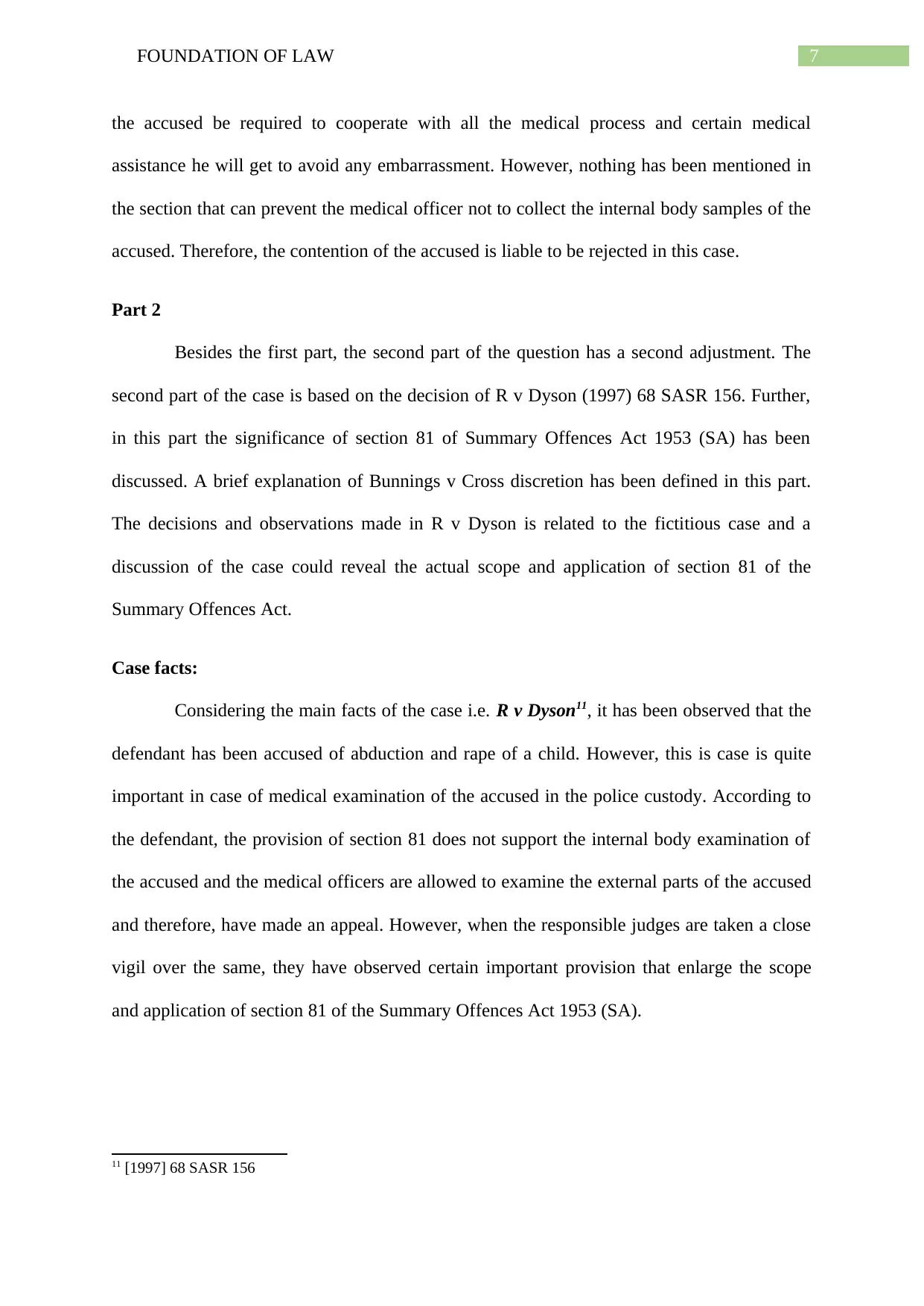
7FOUNDATION OF LAW
the accused be required to cooperate with all the medical process and certain medical
assistance he will get to avoid any embarrassment. However, nothing has been mentioned in
the section that can prevent the medical officer not to collect the internal body samples of the
accused. Therefore, the contention of the accused is liable to be rejected in this case.
Part 2
Besides the first part, the second part of the question has a second adjustment. The
second part of the case is based on the decision of R v Dyson (1997) 68 SASR 156. Further,
in this part the significance of section 81 of Summary Offences Act 1953 (SA) has been
discussed. A brief explanation of Bunnings v Cross discretion has been defined in this part.
The decisions and observations made in R v Dyson is related to the fictitious case and a
discussion of the case could reveal the actual scope and application of section 81 of the
Summary Offences Act.
Case facts:
Considering the main facts of the case i.e. R v Dyson11, it has been observed that the
defendant has been accused of abduction and rape of a child. However, this is case is quite
important in case of medical examination of the accused in the police custody. According to
the defendant, the provision of section 81 does not support the internal body examination of
the accused and the medical officers are allowed to examine the external parts of the accused
and therefore, have made an appeal. However, when the responsible judges are taken a close
vigil over the same, they have observed certain important provision that enlarge the scope
and application of section 81 of the Summary Offences Act 1953 (SA).
11 [1997] 68 SASR 156
the accused be required to cooperate with all the medical process and certain medical
assistance he will get to avoid any embarrassment. However, nothing has been mentioned in
the section that can prevent the medical officer not to collect the internal body samples of the
accused. Therefore, the contention of the accused is liable to be rejected in this case.
Part 2
Besides the first part, the second part of the question has a second adjustment. The
second part of the case is based on the decision of R v Dyson (1997) 68 SASR 156. Further,
in this part the significance of section 81 of Summary Offences Act 1953 (SA) has been
discussed. A brief explanation of Bunnings v Cross discretion has been defined in this part.
The decisions and observations made in R v Dyson is related to the fictitious case and a
discussion of the case could reveal the actual scope and application of section 81 of the
Summary Offences Act.
Case facts:
Considering the main facts of the case i.e. R v Dyson11, it has been observed that the
defendant has been accused of abduction and rape of a child. However, this is case is quite
important in case of medical examination of the accused in the police custody. According to
the defendant, the provision of section 81 does not support the internal body examination of
the accused and the medical officers are allowed to examine the external parts of the accused
and therefore, have made an appeal. However, when the responsible judges are taken a close
vigil over the same, they have observed certain important provision that enlarge the scope
and application of section 81 of the Summary Offences Act 1953 (SA).
11 [1997] 68 SASR 156
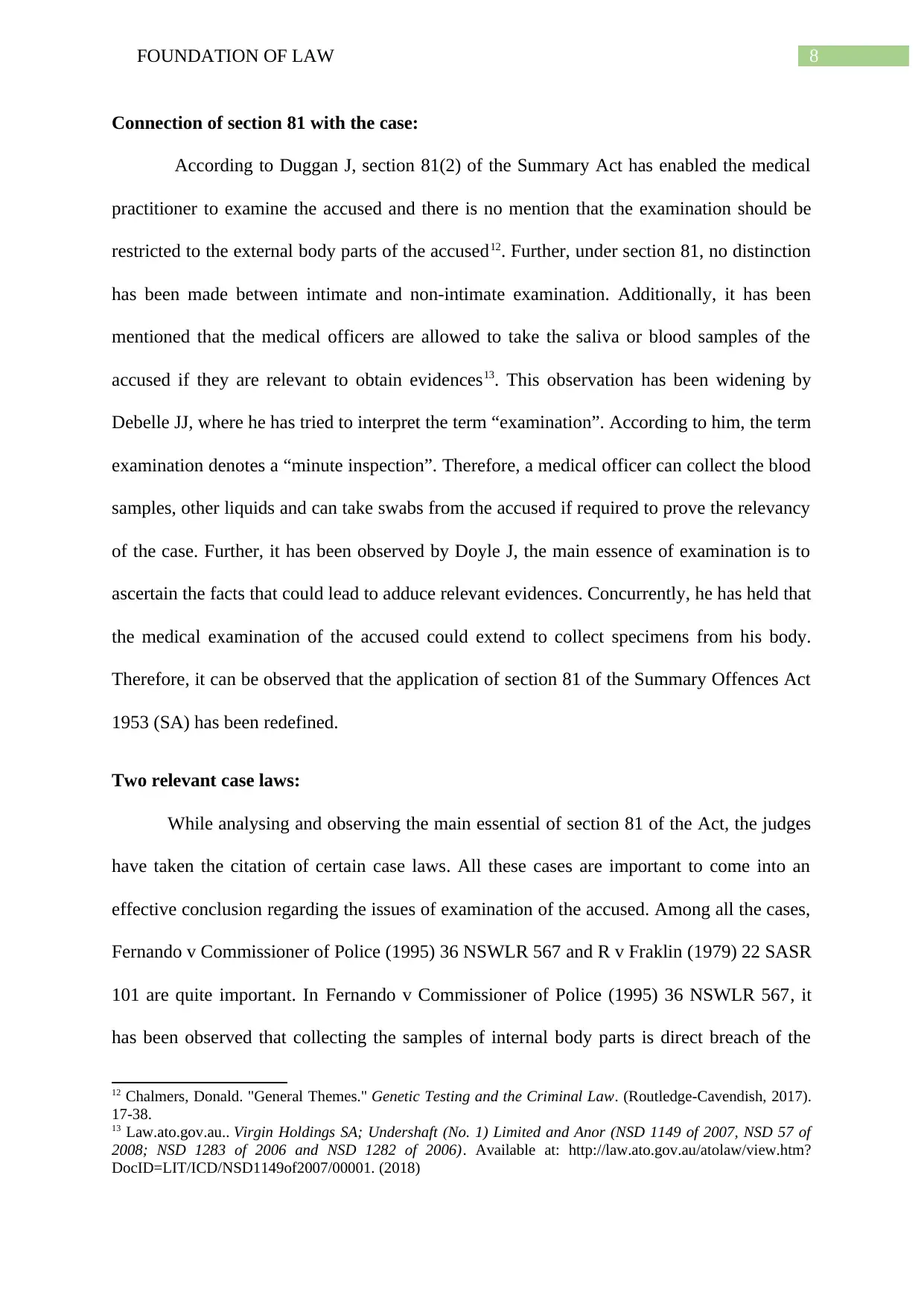
8FOUNDATION OF LAW
Connection of section 81 with the case:
According to Duggan J, section 81(2) of the Summary Act has enabled the medical
practitioner to examine the accused and there is no mention that the examination should be
restricted to the external body parts of the accused12. Further, under section 81, no distinction
has been made between intimate and non-intimate examination. Additionally, it has been
mentioned that the medical officers are allowed to take the saliva or blood samples of the
accused if they are relevant to obtain evidences13. This observation has been widening by
Debelle JJ, where he has tried to interpret the term “examination”. According to him, the term
examination denotes a “minute inspection”. Therefore, a medical officer can collect the blood
samples, other liquids and can take swabs from the accused if required to prove the relevancy
of the case. Further, it has been observed by Doyle J, the main essence of examination is to
ascertain the facts that could lead to adduce relevant evidences. Concurrently, he has held that
the medical examination of the accused could extend to collect specimens from his body.
Therefore, it can be observed that the application of section 81 of the Summary Offences Act
1953 (SA) has been redefined.
Two relevant case laws:
While analysing and observing the main essential of section 81 of the Act, the judges
have taken the citation of certain case laws. All these cases are important to come into an
effective conclusion regarding the issues of examination of the accused. Among all the cases,
Fernando v Commissioner of Police (1995) 36 NSWLR 567 and R v Fraklin (1979) 22 SASR
101 are quite important. In Fernando v Commissioner of Police (1995) 36 NSWLR 567, it
has been observed that collecting the samples of internal body parts is direct breach of the
12 Chalmers, Donald. "General Themes." Genetic Testing and the Criminal Law. (Routledge-Cavendish, 2017).
17-38.
13 Law.ato.gov.au.. Virgin Holdings SA; Undershaft (No. 1) Limited and Anor (NSD 1149 of 2007, NSD 57 of
2008; NSD 1283 of 2006 and NSD 1282 of 2006). Available at: http://law.ato.gov.au/atolaw/view.htm?
DocID=LIT/ICD/NSD1149of2007/00001. (2018)
Connection of section 81 with the case:
According to Duggan J, section 81(2) of the Summary Act has enabled the medical
practitioner to examine the accused and there is no mention that the examination should be
restricted to the external body parts of the accused12. Further, under section 81, no distinction
has been made between intimate and non-intimate examination. Additionally, it has been
mentioned that the medical officers are allowed to take the saliva or blood samples of the
accused if they are relevant to obtain evidences13. This observation has been widening by
Debelle JJ, where he has tried to interpret the term “examination”. According to him, the term
examination denotes a “minute inspection”. Therefore, a medical officer can collect the blood
samples, other liquids and can take swabs from the accused if required to prove the relevancy
of the case. Further, it has been observed by Doyle J, the main essence of examination is to
ascertain the facts that could lead to adduce relevant evidences. Concurrently, he has held that
the medical examination of the accused could extend to collect specimens from his body.
Therefore, it can be observed that the application of section 81 of the Summary Offences Act
1953 (SA) has been redefined.
Two relevant case laws:
While analysing and observing the main essential of section 81 of the Act, the judges
have taken the citation of certain case laws. All these cases are important to come into an
effective conclusion regarding the issues of examination of the accused. Among all the cases,
Fernando v Commissioner of Police (1995) 36 NSWLR 567 and R v Fraklin (1979) 22 SASR
101 are quite important. In Fernando v Commissioner of Police (1995) 36 NSWLR 567, it
has been observed that collecting the samples of internal body parts is direct breach of the
12 Chalmers, Donald. "General Themes." Genetic Testing and the Criminal Law. (Routledge-Cavendish, 2017).
17-38.
13 Law.ato.gov.au.. Virgin Holdings SA; Undershaft (No. 1) Limited and Anor (NSD 1149 of 2007, NSD 57 of
2008; NSD 1283 of 2006 and NSD 1282 of 2006). Available at: http://law.ato.gov.au/atolaw/view.htm?
DocID=LIT/ICD/NSD1149of2007/00001. (2018)
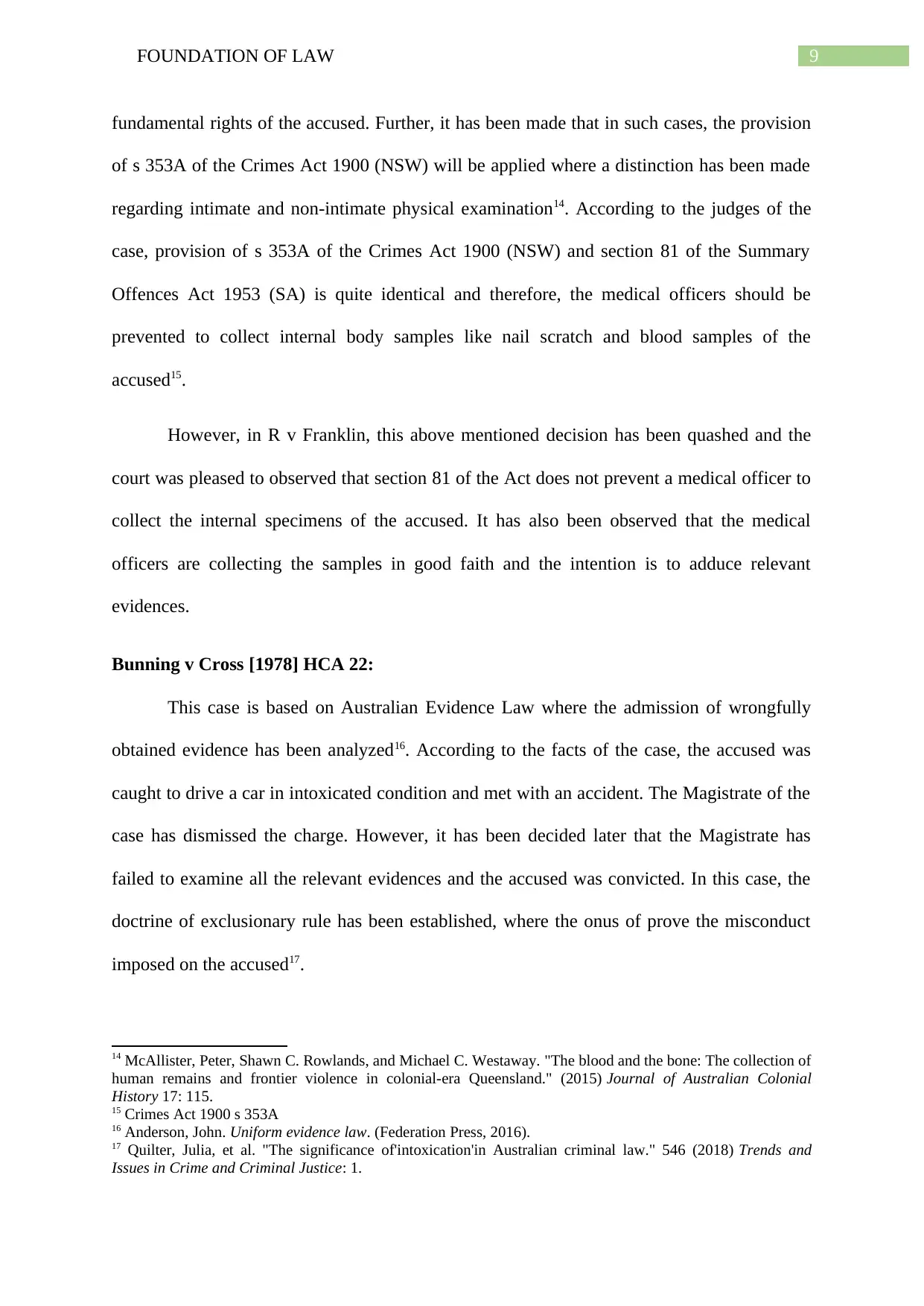
9FOUNDATION OF LAW
fundamental rights of the accused. Further, it has been made that in such cases, the provision
of s 353A of the Crimes Act 1900 (NSW) will be applied where a distinction has been made
regarding intimate and non-intimate physical examination14. According to the judges of the
case, provision of s 353A of the Crimes Act 1900 (NSW) and section 81 of the Summary
Offences Act 1953 (SA) is quite identical and therefore, the medical officers should be
prevented to collect internal body samples like nail scratch and blood samples of the
accused15.
However, in R v Franklin, this above mentioned decision has been quashed and the
court was pleased to observed that section 81 of the Act does not prevent a medical officer to
collect the internal specimens of the accused. It has also been observed that the medical
officers are collecting the samples in good faith and the intention is to adduce relevant
evidences.
Bunning v Cross [1978] HCA 22:
This case is based on Australian Evidence Law where the admission of wrongfully
obtained evidence has been analyzed16. According to the facts of the case, the accused was
caught to drive a car in intoxicated condition and met with an accident. The Magistrate of the
case has dismissed the charge. However, it has been decided later that the Magistrate has
failed to examine all the relevant evidences and the accused was convicted. In this case, the
doctrine of exclusionary rule has been established, where the onus of prove the misconduct
imposed on the accused17.
14 McAllister, Peter, Shawn C. Rowlands, and Michael C. Westaway. "The blood and the bone: The collection of
human remains and frontier violence in colonial-era Queensland." (2015) Journal of Australian Colonial
History 17: 115.
15 Crimes Act 1900 s 353A
16 Anderson, John. Uniform evidence law. (Federation Press, 2016).
17 Quilter, Julia, et al. "The significance of'intoxication'in Australian criminal law." 546 (2018) Trends and
Issues in Crime and Criminal Justice: 1.
fundamental rights of the accused. Further, it has been made that in such cases, the provision
of s 353A of the Crimes Act 1900 (NSW) will be applied where a distinction has been made
regarding intimate and non-intimate physical examination14. According to the judges of the
case, provision of s 353A of the Crimes Act 1900 (NSW) and section 81 of the Summary
Offences Act 1953 (SA) is quite identical and therefore, the medical officers should be
prevented to collect internal body samples like nail scratch and blood samples of the
accused15.
However, in R v Franklin, this above mentioned decision has been quashed and the
court was pleased to observed that section 81 of the Act does not prevent a medical officer to
collect the internal specimens of the accused. It has also been observed that the medical
officers are collecting the samples in good faith and the intention is to adduce relevant
evidences.
Bunning v Cross [1978] HCA 22:
This case is based on Australian Evidence Law where the admission of wrongfully
obtained evidence has been analyzed16. According to the facts of the case, the accused was
caught to drive a car in intoxicated condition and met with an accident. The Magistrate of the
case has dismissed the charge. However, it has been decided later that the Magistrate has
failed to examine all the relevant evidences and the accused was convicted. In this case, the
doctrine of exclusionary rule has been established, where the onus of prove the misconduct
imposed on the accused17.
14 McAllister, Peter, Shawn C. Rowlands, and Michael C. Westaway. "The blood and the bone: The collection of
human remains and frontier violence in colonial-era Queensland." (2015) Journal of Australian Colonial
History 17: 115.
15 Crimes Act 1900 s 353A
16 Anderson, John. Uniform evidence law. (Federation Press, 2016).
17 Quilter, Julia, et al. "The significance of'intoxication'in Australian criminal law." 546 (2018) Trends and
Issues in Crime and Criminal Justice: 1.
Secure Best Marks with AI Grader
Need help grading? Try our AI Grader for instant feedback on your assignments.
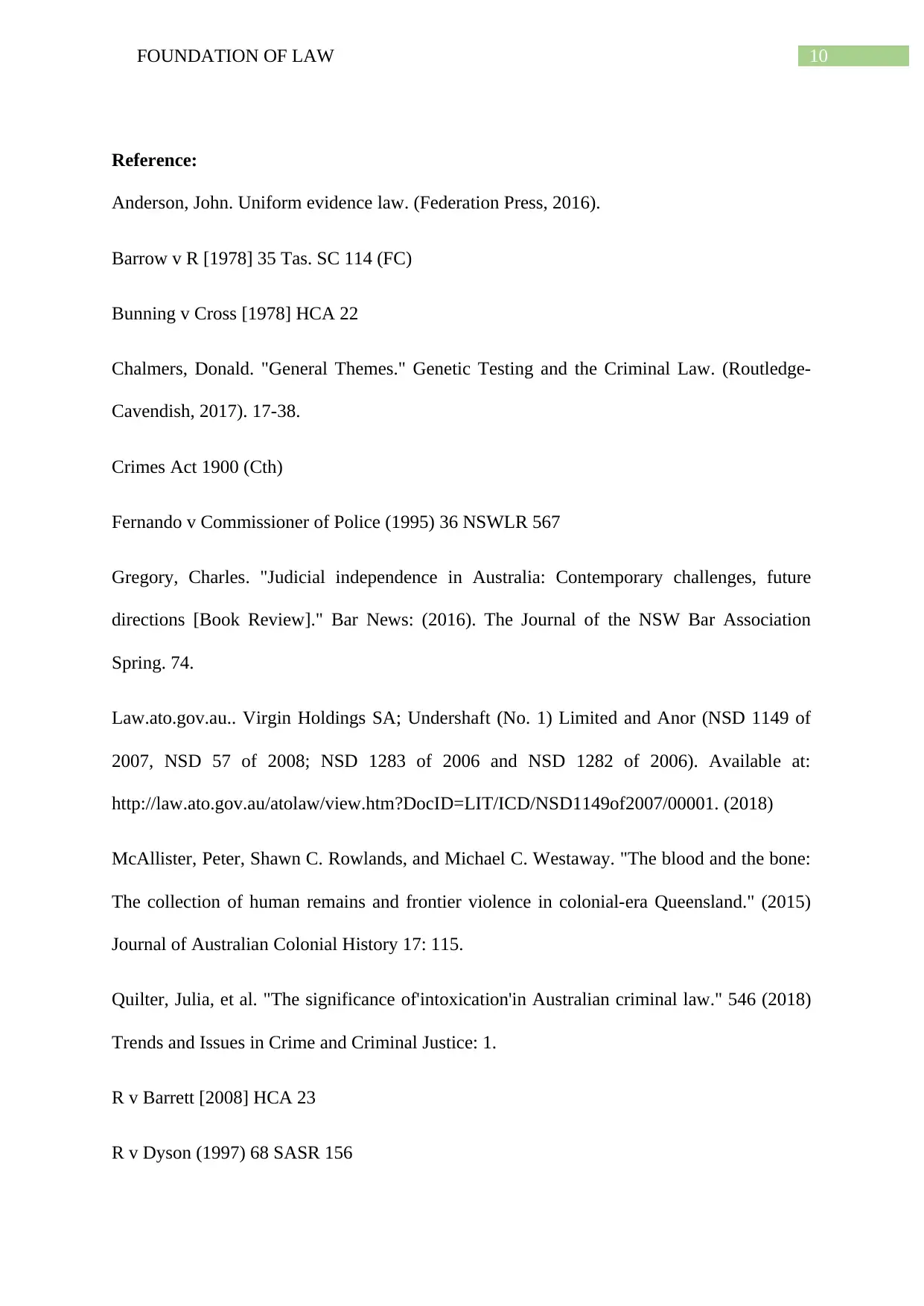
10FOUNDATION OF LAW
Reference:
Anderson, John. Uniform evidence law. (Federation Press, 2016).
Barrow v R [1978] 35 Tas. SC 114 (FC)
Bunning v Cross [1978] HCA 22
Chalmers, Donald. "General Themes." Genetic Testing and the Criminal Law. (Routledge-
Cavendish, 2017). 17-38.
Crimes Act 1900 (Cth)
Fernando v Commissioner of Police (1995) 36 NSWLR 567
Gregory, Charles. "Judicial independence in Australia: Contemporary challenges, future
directions [Book Review]." Bar News: (2016). The Journal of the NSW Bar Association
Spring. 74.
Law.ato.gov.au.. Virgin Holdings SA; Undershaft (No. 1) Limited and Anor (NSD 1149 of
2007, NSD 57 of 2008; NSD 1283 of 2006 and NSD 1282 of 2006). Available at:
http://law.ato.gov.au/atolaw/view.htm?DocID=LIT/ICD/NSD1149of2007/00001. (2018)
McAllister, Peter, Shawn C. Rowlands, and Michael C. Westaway. "The blood and the bone:
The collection of human remains and frontier violence in colonial-era Queensland." (2015)
Journal of Australian Colonial History 17: 115.
Quilter, Julia, et al. "The significance of'intoxication'in Australian criminal law." 546 (2018)
Trends and Issues in Crime and Criminal Justice: 1.
R v Barrett [2008] HCA 23
R v Dyson (1997) 68 SASR 156
Reference:
Anderson, John. Uniform evidence law. (Federation Press, 2016).
Barrow v R [1978] 35 Tas. SC 114 (FC)
Bunning v Cross [1978] HCA 22
Chalmers, Donald. "General Themes." Genetic Testing and the Criminal Law. (Routledge-
Cavendish, 2017). 17-38.
Crimes Act 1900 (Cth)
Fernando v Commissioner of Police (1995) 36 NSWLR 567
Gregory, Charles. "Judicial independence in Australia: Contemporary challenges, future
directions [Book Review]." Bar News: (2016). The Journal of the NSW Bar Association
Spring. 74.
Law.ato.gov.au.. Virgin Holdings SA; Undershaft (No. 1) Limited and Anor (NSD 1149 of
2007, NSD 57 of 2008; NSD 1283 of 2006 and NSD 1282 of 2006). Available at:
http://law.ato.gov.au/atolaw/view.htm?DocID=LIT/ICD/NSD1149of2007/00001. (2018)
McAllister, Peter, Shawn C. Rowlands, and Michael C. Westaway. "The blood and the bone:
The collection of human remains and frontier violence in colonial-era Queensland." (2015)
Journal of Australian Colonial History 17: 115.
Quilter, Julia, et al. "The significance of'intoxication'in Australian criminal law." 546 (2018)
Trends and Issues in Crime and Criminal Justice: 1.
R v Barrett [2008] HCA 23
R v Dyson (1997) 68 SASR 156
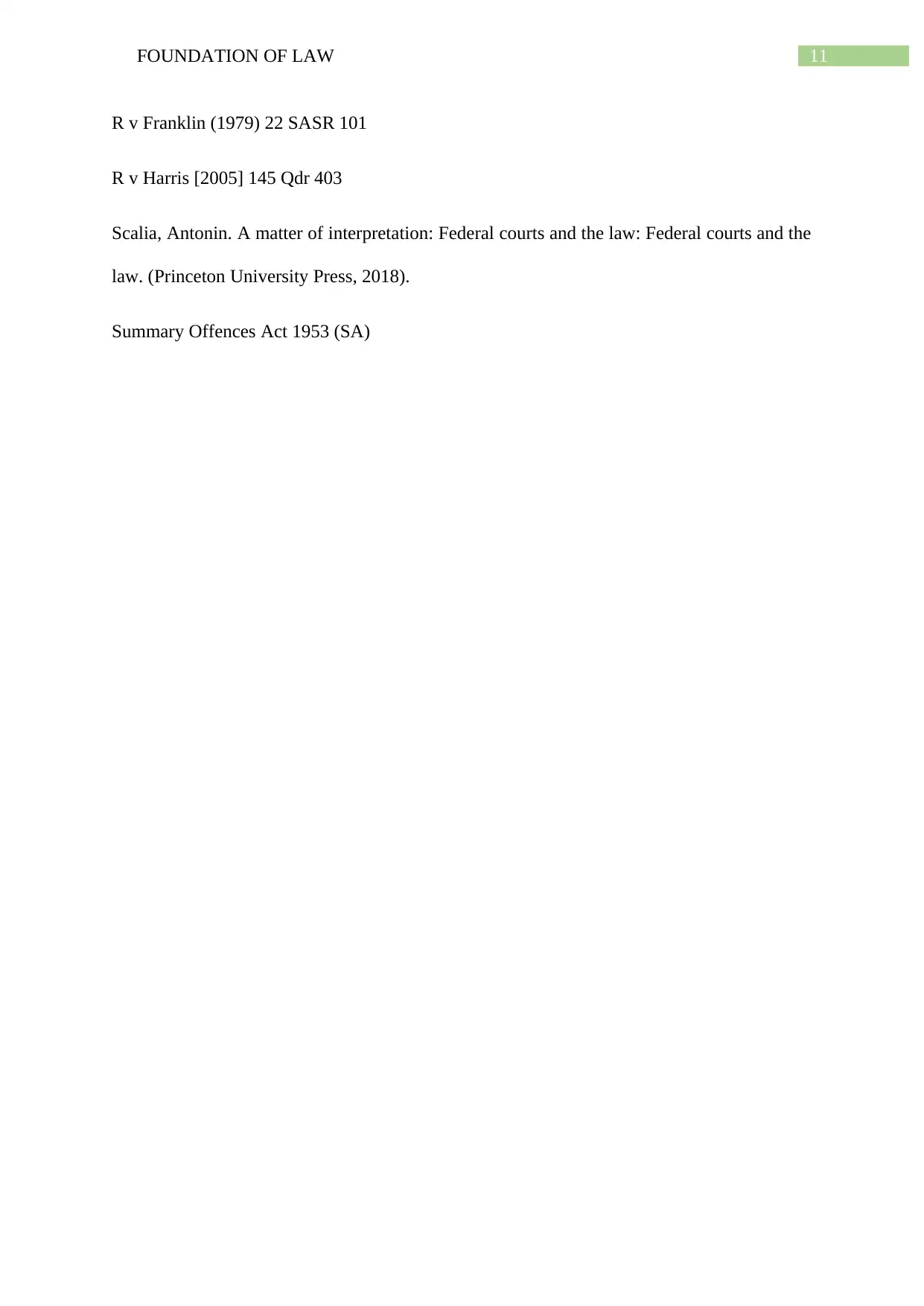
11FOUNDATION OF LAW
R v Franklin (1979) 22 SASR 101
R v Harris [2005] 145 Qdr 403
Scalia, Antonin. A matter of interpretation: Federal courts and the law: Federal courts and the
law. (Princeton University Press, 2018).
Summary Offences Act 1953 (SA)
R v Franklin (1979) 22 SASR 101
R v Harris [2005] 145 Qdr 403
Scalia, Antonin. A matter of interpretation: Federal courts and the law: Federal courts and the
law. (Princeton University Press, 2018).
Summary Offences Act 1953 (SA)

12FOUNDATION OF LAW
1 out of 13
Related Documents
Your All-in-One AI-Powered Toolkit for Academic Success.
+13062052269
info@desklib.com
Available 24*7 on WhatsApp / Email
![[object Object]](/_next/static/media/star-bottom.7253800d.svg)
Unlock your academic potential
© 2024 | Zucol Services PVT LTD | All rights reserved.




![Academy Cleaning & Security Pty Ltd v Deputy Commissioner of Taxation [2017]: Taxation Law](/_next/image/?url=https%3A%2F%2Fdesklib.com%2Fmedia%2Facademy-cleaning-security-taxation_page_2.jpg&w=256&q=75)
